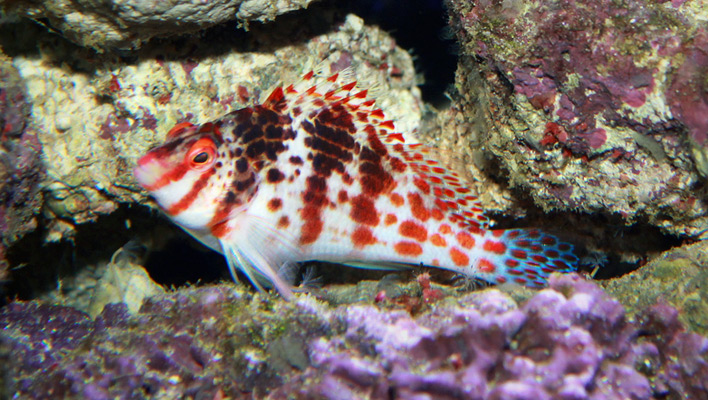Looking back at the various marine aquariums I’ve kept over the years, it occurs to me that one particular species has probably been included in my livestock lineups more often than any other—Falco’s hawkfish (Cirrhitichthys falco), a.k.a. the dwarf hawkfish.
If there’s a marine fish that’s hardier, easier to feed, and more entertaining to observe than this Indo-Pacific species, I’m not aware of it. What’s more, C. falco is a great choice for hobbyists of all experience levels—from beginners to experts—and is even well suited to relatively small aquarium systems.
Physical characteristics
C. falco is white overall with rusty reddish-orange stripes on its face and similarly colored spots and blotches forming vertical bands along its flanks. Its rear dorsal and caudal fins are polka-dotted.
In shape, C. falco vaguely resembles an American football, and its eyes are set high on its head. Short, hair-like filaments (called cirri) are clustered at the tip of each dorsal spine. These tufts could easily be mistaken for coral polyps and, in addition to the blotchy coloration, serve to camouflage the species among invertebrates on the reef. C. falco is a small hawkfish species, reaching just under 3 inches in maximum length.
Rock-hopping habits
Lacking a swim bladder, C. falco is usually found perched on the rocks and substrate (including sessile invertebrates) and locomotes by sort of scooting from spot to spot in short swimming bursts. Specimens may occasionally hover briefly in the water column when food is introduced, but they can’t sustain that orientation for very long. Given its diminutive size and bottom-dwelling nature, Falco’s hawkfish does not demand an especially large aquarium system. A 30-gallon tank is more than adequate housing.
A bottom-dwelling hawk?
Okay, so how does a clumsy-swimming, bottom-dwelling species manage to acquire the common name “hawkfish,” which evokes images of graceful soaring? This moniker is based on fish’s tendency to perch on a rock or coral and swoop down onto any passing prey items, such as small crustaceans, that catch its constant gaze.
Here’s looking at you!
And it’s not just prey items that will draw C. falco’s eye. In fact, one of this species’ more endearing traits is the manner in which it seems to keep a close eye on any and all goings on in its environment—including its keeper’s movements outside the tank. Owning a hawkfish can be a bit like having one of those old painted portraits with the eyes that follow you wherever you go in the room.
Easy feeding
In nature, C. falco feeds primarily on very small crustaceans, so items like mysis shrimp, various finely chopped seafoods, and commercial formulations for smaller carnivores will make good substitutes in the aquarium. Every specimen I’ve kept has begun feeding immediately and learned to accept just about everything offered, including dry pellets and flakes.
Hawk-friendly tankmates
I would describe C. falco as moderately aggressive. It’s not the biggest bully in the sea, but it may torment smaller, more passive fishes, especially those introduced after the hawkfish. Otherwise, any fishes that are similar in size or larger and assertive enough to hold their own will likely be ignored.
With respect to sessile invertebrates, C. falco can be considered reef-safe with one important caveat: If it adopts a coral as its favorite perching places, it may cause the coral to constantly withdraw its tissues, which can affect its health over time. To minimize the likelihood of this occurring, it’s a good idea to include several rocks in the reef structure that don’t have corals attached to or encrusting them. There’s no surefire guarantee that adding these alternate perches will prevent corals from being pestered, but it can certainly help.



